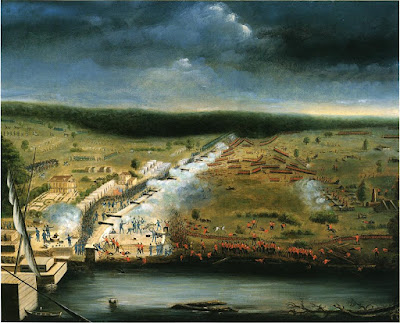
Cotton bales and Cannonballs

 |
| "View of the Battle of New Orleans" by Jean Hyacinthe Laclotte, 1815. The artist was one of Jackson's engineers present at the battle. |
In April of 1814 Napoleon capitulated to the Allied Powers of Europe enabling England to shift the resources of thousands of battle-hardened veterans to America. On the advise of Vice-Admiral Cochrane, the War Ministry of England would mount it’s most ambitious campaign yet against the American south. The goal at this point was to end the war on favorable terms. If England could take New Orleans, it would secure a major port of entry into the United States whereby the military could… “occupy some important and valuable possession by the restoration of which we may improve the conditions of peace, or which may entitle us to exact its cession as the price of peace.” Jackson received word from Secretary of War James Monroe in October elucidating the mounting fear that, should the British capture New Orleans, they would be free to move into the interior of the country and sever the United States. The British were coming, and it was up to Andrew Jackson to stop them. Although various actions occurred all along the Gulf Coast during England’s amphibious campaign of conquest, the affair, as speculated, was decided at New Orleans. After several smaller actions, the British Army launched their main attack on January 8th of the new year, 1815. Jackson’s force of regular army, militia, volunteers, free blacks, allied Indians, and pirates dealt a crushing defeat to the guardians of the British Empire that had vanquished Napoleon.
The battle was overwhelmingly one-sided. Waves of red-coated British regulars repeatedly tried to breach the earthworks and silence the guns placed on cotton bales from behind which the American line held firm and shot down their attackers without regard. Total American losses were reported at 333. The total casualties, including three generals, for the British was 2,459 of which their Commanding General, Sir Edward Pakenham was among the slain. The Treaty of Ghent, which had actually been signed on Christmas Eve of 1814, was finally known to the combatants in mid February. The British abandoned the recently captured Fort Bowyer and sailed off to the West Indies.
 |
| The Battle of New Orleans by Eugene Louis Lami, 1839. |
Going Home
Once again the Natchez Trace echoed with the footfalls of thousands of soldiers as they returned to their homes in the Mississippi Territory, Tennessee, and Kentucky. The passing phalanx of men and animals is best described by one who witnessed it. The Methodist Reverend John G. Jones lived on the Natchez Trace at the time and recorded his impressions for posterity… “Mail was limited and newspapers few, so by concert signal, guns were fired at given points along the Mississippi River all the way to Natchez to let the people know of the victory. The news went from mouth to ear all the way to Alabama, and was soon followed by official news of a permanent peace, then word of “soldiers return.” First came the heavy brigade of Tennessee infantry; then came regiments of mounted riflemen, and squadrons of light dragoons of various sizes, followed by smaller detachments of both infantry and cavalry, and last came the sick and their attendants, and for months (I) seldom looked up or down the Natchez Trace without seeing passing soldiers. The war was over.”